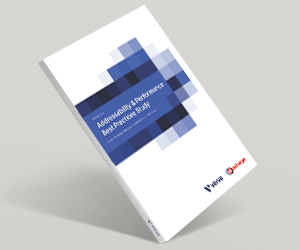In the fast-paced world of mobile app development, ensuring the quality and security of your code is not just a best practice—it’s a necessity. This is where the critical process of code audits comes into play.
With the increasing complexity of mobile applications and the ever-evolving landscape of cybersecurity threats, regular audits have become a cornerstone in the development lifecycle.
In this article, we aim to demystify the process of conducting a mobile code audit. We’ll provide a step-by-step guide, incorporating best practices to ensure that your code is not only functional and efficient but also secure and scalable.
Understanding mobile code audits
What is a mobile code audit?
A code audit, in the context of mobile development, is a thorough review of source code to identify bugs, security breaches, and inefficiencies. It’s akin to a comprehensive health check for your app’s code, ensuring it not only meets current industry standards but is also prepared for future challenges.
Advantages of code audits
Source: Softjourn
Goals and benefits
The primary goal of a mobile code audit is to ensure the highest quality of the mobile app. Quality, in this context, encompasses several key aspects:
- Efficiency and Performance: The code should be optimized for the best possible performance on mobile devices, taking into account factors like memory usage and battery efficiency.
- Security: Given the sensitive nature of data handled by mobile apps, security is paramount. A code audit aims to uncover any vulnerabilities that could be exploited by malicious entities.
- Maintainability and Scalability: The code should be clean, well-organized, and easy to maintain. This ensures that the app can evolve, adapting to new requirements or technologies without significant overhauls.
Conducting regular code audits provides numerous benefits. It helps in early detection of potential issues, reduces long-term maintenance costs, and ensures a consistent, high-quality user experience. Additionally, it fosters trust among users and stakeholders, as it demonstrates a commitment to maintaining high standards of quality and security.
Types of code audits
Code audits vary in approach, including manual reviews by experts, automated scans using specialized tools, and hybrid methods that combine both for thorough analysis. Each serves a unique purpose in ensuring code quality and security.
Preparing for a mobile code audit
Effective preparation is key to a successful code audit. This involves clearly defining what parts of the app will be examined, setting specific goals for the audit, ensuring all relevant documentation is accessible, and choosing the right tools for either manual or automated analysis.
Assemble the audit team
Internal vs. External auditors: Deciding between internal team members and external experts is crucial in a code audit. Internal auditors bring an in-depth understanding of the code, while external auditors offer an unbiased perspective.
🚀 Grow Your App! Free ASO Audit by Award-Winning Agency
Discover how Yodel Mobile, the App Marketing Agency of the Year, can transform your app. Gain insights with our free ASO audit, proven in elevating apps like B&Q, Afterpay and Gymshark. 🌟
Get StartedConducting the audit
Conducting a code audit is a meticulous process. Breaking it down into manageable steps can make the task less daunting and more efficient. Here’s how to proceed:
Step 1: Reviewing code quality
- Code Standards and Best Practices: Start by assessing the code against established coding standards and best practices. This includes reviewing naming conventions, commenting, and the overall structure.
- Code Efficiency: Evaluate the efficiency of the code. Look for redundant or unnecessary code segments that could be optimized for better performance.
- Readability and Maintainability: Ensure the code is readable and maintainable. Well-organized code with clear documentation is easier to update and debug.
Step 2: Assessing security vulnerabilities
- Identifying Potential Threats: Use automated tools to scan for common security vulnerabilities like SQL injections, cross-site scripting, or outdated libraries.
- Manual Review for Complex Issues: In addition to automated tools, conduct a manual review to identify more complex security issues that require human expertise and contextual understanding.
- Compliance with Security Standards: Verify that the code adheres to industry-specific security standards and guidelines.
Step 3: Analyzing performance and scalability
- Performance Testing: Utilize performance testing tools to check how the code behaves under various conditions, such as high user load or data processing demands.
- Scalability Analysis: Assess whether the code is scalable. Ensure that it can handle growth in user numbers or data volume without significant modifications.
- Memory and Resource Usage: Evaluate the app’s memory footprint and resource usage, crucial for mobile devices with limited resources.
Step 4 (optional): Incorporating quality assurance (QA) audits
- Functional and User Experience Review: While not typically a part of traditional code audits, incorporating QA audits can significantly enhance the value of the process, particularly for mobile applications. This step involves assessing the functionality of the app to ensure all features operate as intended and evaluating the user interface for usability and user experience consistency.
- Performance and Compatibility Testing: Another crucial aspect of QA audits is to test the app’s performance under various conditions and its compatibility across different devices and operating systems. This ensures that the app delivers a stable, efficient, and consistent experience for all users.
Step 5: Documentation and reporting
- Comprehensive Reporting: Document all findings from the audit. This report should be detailed, categorizing issues based on severity and suggesting potential solutions.
- Feedback Sessions: Conduct feedback sessions with the development team to discuss the findings and plan the next steps.
Interpreting audit results and taking action
Post-audit, it’s critical to assess results and plan actions. Key steps include:
- Categorizing issues: Classify findings by severity (critical, major, minor) to prioritize.
- Impact analysis: Assess each issue’s effect on performance, security, and user experience to guide corrective measures.
- Action plan:
- Prioritization: Tackle critical security and user experience issues first to ensure app stability.
- Roadmap creation: Outline a plan with timelines and responsibilities for addressing issues.
- Implementation:
- Team collaboration: Involve the development team for effective issue resolution and knowledge sharing.
- Progress monitoring: Regularly check implementation status to ensure expected outcomes.
- Re-auditing:
- Follow-up: Conduct audits post-implementation to confirm issue resolution and identify new areas for improvement.
- Continuous improvement: Treat code auditing as a regular practice for sustained app quality and adaptability to new standards.
Process of a code audit
Source: Softjourn
Overcoming common challenges in mobile code audits
Mobile code audits can present a range of challenges. Being aware of these and knowing how to address them can make the audit process more efficient and effective.
Challenge 1: Large and complex codebases
- Solution: Break down the audit process into manageable segments. Focus on one module or functionality at a time. This makes it easier to identify issues without getting overwhelmed by the complexity.
Challenge 2: Keeping up with evolving technologies
- Solution: Stay updated with the latest development trends and tools. Regular training and workshops for the audit team can help in adapting to new technologies and methodologies.
Challenge 3: Ensuring objectivity
- Solution: The engagement of external auditors can be pivotal in achieving an unbiased perspective in code audits. A third-party analysis often uncovers critical insights that might be missed by internal teams, due to overfamiliarity with the codebase.
For instance, in a compelling case study by Softjourn, the introduction of external auditors was instrumental. Our team successfully identified significant issues within a client’s code that the internal team had overlooked. This third-party intervention not only brought these hidden issues to light but also empowered the client with the confidence they needed in their code integrity before entering into crucial negotiations with a seller.
By anticipating and addressing these challenges, you can ensure that your mobile code audits are thorough, efficient, and beneficial in maintaining the high quality and security of your mobile application.
Final words
The journey through mobile code audits is a vital one for any mobile application’s lifecycle. Code audits are not just a task to be checked off; they are an ongoing commitment to maintaining high standards in app quality and security.
By embracing the practices of effective mobile code auditing, developers and teams can ensure their applications stand the test of time and technology, continually meeting and exceeding user expectations.














